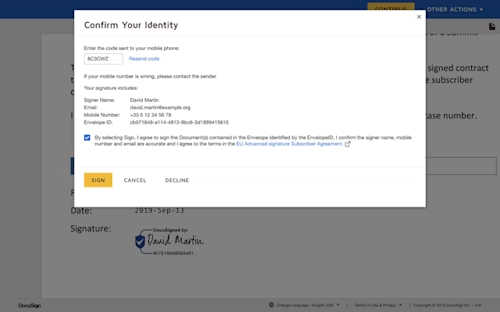HR 2021: Trends and Opportunities Report

What makes e-signature legal in Canada and around the world? Which documents can't you e-sign in Canada? Are they legally binding? Here's what you need to know.


Electronic signatures (e-signatures), which demonstrate an individual’s intent to agree to something, aren’t new. Their acceptance and use in many countries around the world have been widespread for years. Hundreds of millions of users worldwide rely on e-signatures to sign documents electronically. But, are electronic signatures legal?
The answer is yes, electronic signatures are legal. But what this question is really getting at is whether an e-signature can create a binding and enforceable contract. Again, the answer is yes. Electronic signatures are recognized and accepted throughout the industrialized world; they’re also more secure than traditional paper-based signatures and thus less susceptible to forgery.
In this post, we’ll cover what makes e-signatures legally binding in Canada, whether they’re valid in all provinces and U.S. states, and other types of e-signatures accepted around the world. We’ll cover what exactly an e-signature is; a lot of people think it’s the digital image of the “squiggly line” like your wet signature, but that’s not the case. We’ll explain the differences between electronic signature, digital signature, and standards-based signature, and more.
In a word: law. In Canada, an e-signature has the same legal status as a handwritten signature. Electronic signature in Canada is regulated federally by PIPEDA, the Personal Information and Electronic Documents Act. To promote uniformity in electronic commerce across the country, all provinces (except Quebec) have enacted legislation based on UECA, the Uniform Electronic Commerce Act. Quebec has its own comparable law (CQLR c C-1.1) establishing that “electronic signatures and documents have the same legal weight as their paper equivalent.”
Similar laws around the world have been enacted to ensure enforceability of e-signatures which are broadly recognized as carrying the same legal effect as traditional handwritten signatures. In the U.S., it’s ESIGN, the Electronic Signatures in Global and National Commerce Act and the UETA, Uniform Electronic Transactions Act – making e-signatures valid in all U.S. states with the same legal status as handwritten signatures under state laws.
In the EU, eIDAS, the Electronic Identification and Trust Services Regulation, regulates e-signatures. In fact, electronic signatures are valid in over 180 countries, making it easy to do business across the border and overseas. This helpful Legality Guide has detailed information on legal use of e-signatures around the world.
Worth noting is when e-signatures are combined with tamper seals, strong authentication, world-class security and an audit trail, they can be more enforceable than wet signatures because of the court admissible evidence they contain.
There are some exceptions to these laws (see below “Can legal documents be signed electronically?”). However, it may not be that e-signatures can’t be used in these situations, it’s just that they may be subject to additional legal requirements in order to be enforceable. Always look to the laws in your jurisdiction regarding your specific e-signature use case.
Yes. In addition to e-signature use for general commercial transactions, many legal documents can also be signed electronically, including: non-disclosure agreements, real estate property transactions, medical releases, settlements, and more.
Expressly excluded from the list of legal documents and the use of e-signature in Canada are:
Wills and codicils
Trusts created by wills or codicils
Powers of attorney pertaining to finances or personal care
Negotiable instruments such as promissory notes
Notarizations
The terms “digital signature” and “electronic signature” are often used interchangeably, but they’re actually different.
Electronic signatures cover the full range of technologies and solutions to create signatures electronically, from simple images of a digital signature file attached to an electronic document, to PKI-based signatures (more on that below).
A variety of methods can be used to capture signatures electronically, such as:
Typing your name in a signature box
Signing your name on a courier’s digital device
Using an e-signature solution like Docusign
Digital signatures are a specific type of e-signature that has an additional signer authentication element. Digital signatures include a “digital certificate” that is issued only when the identity of the signer is validated. A special type of encryption called public key infrastructure (PKI) is used to associate the signer with the document – providing additional assurance of the signer’s identity.
The extra steps needed to obtain a digital signature are not necessary for the majority of transactions in North America, so they’re rarely used. An electronic signature, like Docusign eSignature, is typically all a customer needs to create a legally enforceable document, as every agreement includes a Certificate of Completion providing tamper-proof evidence of the entire signing process.

In signing situations where more authentication is required, such as industry-specific compliance documents like FDA 21 CFR Part 11, a Standards-Based signature can be used to digitally sign a document. Standards-Based signatures are common in the European Union and are more routinely used there for signing legal documents and government-related paperwork.
Yes. Top-tier, credible electronic signature platforms such as Docusign eSignature can help you comply with PIPEDA, ESIGN, UETA, eIDAS, and other national laws worldwide, enabling you to sign agreements that are legally enforceable both here and abroad.
Be sure your e-signature vendor automatically generates and stores a complete, time-stamped history of every send, view, print, sign or decline action. This important audit information, with evidence for every signer, is typically captured in a Certificate of Completion for each transaction and provides reliable proof for legally binding electronic signatures.
Electronic signature audit data can be used to legally –
Verify signer identities with multiple forms of authentication
Confirm signer intent to sign electronically
Link individual signatures to signers and documents
Record and time all important document and signature activities
Allow ongoing, secure authorized-only access to documents
Protect documents with tamper seals that use a combination of secure system processes and PKI

Related posts




